A Method of Noise Reduction for Radio Communication Signal Based on RaGAN
Abstract
1. Introduction
- A noise reduction algorithm based on RaGAN is proposed for time-series data of radio communication signals;
- Our method preserves the essential characteristics of the signal after noise reduction of the radio signal;
- The experimental results show that the accuracy of modulation recognition is improved by about 10% after using this method to denoise the signal with low SNR compared with the signal before noise reduction.
2. Related Work
3. Background
3.1. Problem Definition and System Model
3.2. Generative Adversarial Network
4. Signal Denoising Method Based on RaGAN
4.1. Denoising Model
4.2. Dataset
4.3. Network Structure
4.3.1. Generator Network Structure
4.3.2. Discriminator Network Structure
4.4. Loss Function
5. Experiments
5.1. Training Details and Parameters
5.2. Experimental Result
5.3. Exploration of Bi-LSTM in the Model
6. Conclusions
Author Contributions
Funding
Institutional Review Board Statement
Informed Consent Statement
Data Availability Statement
Conflicts of Interest
References
- Banafaa, M.; Shayea, I.; Din, J.; Azmi, M.H.; Alashbi, A.; Daradkeh, Y.I.; Alhammadi, A. 6G Mobile Communication Technology: Requirements, Targets, Applications, Challenges, Advantages, and Opportunities. Alex. Eng. J. 2022. [Google Scholar] [CrossRef]
- Xiao, W.; Luo, Z.; Hu, Q. A Review of Research on Signal Modulation Recognition Based on Deep Learning. Electronics 2022, 11, 2764. [Google Scholar] [CrossRef]
- Dautov, Ç.P.; Özerdem, M.S. Wavelet transform and signal denoising using Wavelet method. In Proceedings of the 2018 26th Signal Processing and Communications Applications Conference (SIU), Izmir, Turkey, 2–5 May 2018; pp. 1–4. [Google Scholar]
- Guo, T.; Zhang, T.; Lim, E.; Lopez-Benitez, M.; Ma, F.; Yu, L. A Review of Wavelet Analysis and Its Applications: Challenges and Opportunities. IEEE Access 2022, 10, 58869–58903. [Google Scholar] [CrossRef]
- Wei, H.; Qi, T.; Feng, G.; Jiang, H. Comparative research on noise reduction of transient electromagnetic signals based on empirical mode decomposition and variational mode decomposition. Radio Sci. 2021, 56, e2020RS007135. [Google Scholar] [CrossRef]
- Mohamed, A.; Lee, H.-y.; Borgholt, L.; Havtorn, J.D.; Edin, J.; Igel, C.; Kirchhoff, K.; Li, S.-W.; Livescu, K.; Maaløe, L. Self-Supervised Speech Representation Learning: A Review. arXiv 2022, arXiv:2205.10643. [Google Scholar] [CrossRef]
- Celard, P.; Iglesias, E.; Sorribes-Fdez, J.; Romero, R.; Vieira, A.S.; Borrajo, L. A survey on deep learning applied to medical images: From simple artificial neural networks to generative models. Neural Comput. Appl. 2022, 1–33. [Google Scholar] [CrossRef]
- Kaur, N.; Singh, P. Conventional and contemporary approaches used in text to speech synthesis: A review. Artif. Intell. Rev. 2022, 1–44. [Google Scholar] [CrossRef]
- Zhu, W.; Mousavi, S.M.; Beroza, G.C. Seismic signal denoising and decomposition using deep neural networks. IEEE Trans. Geosci. Remote Sens. 2019, 57, 9476–9488. [Google Scholar] [CrossRef]
- Wang, M.; Lin, F.; Chen, K.; Luo, W.; Qiang, S. TEM-NLnet: A Deep Denoising Network for Transient Electromagnetic Signal with Noise Learning. IEEE Trans. Geosci. Remote Sens. 2022, 60, 1–14. [Google Scholar] [CrossRef]
- Chen, K.; Pu, X.; Ren, Y.; Qiu, H.; Lin, F.; Zhang, S. TEMDNet: A novel deep denoising network for transient electromagnetic signal with signal-to-image transformation. IEEE Trans. Geosci. Remote Sens. 2020, 60, 1–18. [Google Scholar] [CrossRef]
- Goodfellow, I.; Pouget-Abadie, J.; Mirza, M.; Xu, B.; Warde-Farley, D.; Ozair, S.; Courville, A.; Bengio, Y. Generative adversarial nets. arXiv 2014, arXiv:1406.2661. [Google Scholar] [CrossRef]
- Singh, P.; Pradhan, G. A new ECG denoising framework using generative adversarial network. IEEE/ACM Trans. Comput. Biol. Bioinform. 2020, 18, 759–764. [Google Scholar] [CrossRef]
- Wang, X.; Chen, B.; Zeng, M.; Wang, Y.; Liu, H.; Liu, R.; Tian, L.; Lu, X. An ECG Signal Denoising Method Using Conditional Generative Adversarial Net. IEEE J. Biomed. Health Inform. 2022, 26, 2929–2940. [Google Scholar] [CrossRef]
- Soltani, A.A.; El-Hag, A. Denoising of radio frequency partial discharge signals using artificial neural network. Energies 2019, 12, 3485. [Google Scholar] [CrossRef]
- Jolicoeur-Martineau, A. The relativistic discriminator: A key element missing from standard GAN. arXiv 2018, arXiv:1807.00734. [Google Scholar] [CrossRef]
- Zhou, P.; Shi, W.; Tian, J.; Qi, Z.; Li, B.; Hao, H.; Xu, B. Attention-based bidirectional long short-term memory networks for relation classification. In Proceedings of the 54th Annual Meeting of the Association for Computational Linguistics (Volume 2: Short Papers), Berlin, Germany, 7–12 August 2016; pp. 207–212. [Google Scholar]
- O’Shea, T.J.; Corgan, J.; Clancy, T.C. Convolutional radio modulation recognition networks. In Proceedings of the International Conference on Engineering Applications of Neural Networks, Aberdeen, UK, 2–5 September 2016; pp. 213–226. [Google Scholar]
- Cui, T.S. A Deep Learning Method for Space-Based Electromagnetic Signal Recognition. Ph.D. Thesis, University of Chinese Academy of Sciences (National Center for Space Science, Chinese Academy of Sciences), Beijing, China, 2021. [Google Scholar]
- Senapati, R.K.; Tanna, P.J. Deep Learning-Based NOMA System for Enhancement of 5G Networks: A Review. IEEE Trans. Neural Netw. Learn. Syst. 2022, 1–15. [Google Scholar] [CrossRef]
- Wang, H.; Wang, B.; Li, Y. IAFNet: Few-Shot Learning for Modulation Recognition in Underwater Impulsive Noise. IEEE Commun. Lett. 2022, 26, 1047–1051. [Google Scholar] [CrossRef]
- Mao, X.; Li, Q.; Xie, H.; Lau, R.Y.; Wang, Z.; Paul Smolley, S. Least squares generative adversarial networks. In Proceedings of the IEEE International Conference on Computer Vision, Venice, Italy, 22–29 October 2017; pp. 2794–2802. [Google Scholar]
- Odena, A.; Olah, C.; Shlens, J. Conditional Image Synthesis with Auxiliary Classifier GANs. In Proceedings of the 34th International Conference on Machine Learning, Proceedings of Machine Learning Research, Sydney, Australia, 6–11 August 2017; pp. 2642–2651. [Google Scholar]
- Awon, N.T.; Islam, M.; Rahman, M.; Islam, A. Effect of AWGN & Fading (Raleigh & Rician) channels on BER performance of a WiMAX communication System. arXiv 2012, arXiv:1211.4294. [Google Scholar] [CrossRef]
- O’Shea, T.J.; West, N. Radio Machine Learning Dataset Generation with GNU Radio. In Proceedings of the GNU Radio Conference, Charlotte, NC, USA, 20–24 September 2016. [Google Scholar]
- Hochreiter, S.; Schmidhuber, J. Long short-term memory. Neural Comput. 1997, 9, 1735–1780. [Google Scholar] [CrossRef]
- Srivastava, N.; Hinton, G.; Krizhevsky, A.; Sutskever, I.; Salakhutdinov, R. Dropout: A simple way to prevent neural networks from overfitting. J. Mach. Learn. Res. 2014, 15, 1929–1958. [Google Scholar]
- Ba, J.L.; Kiros, J.R.; Hinton, G.E. Layer normalization. arXiv 2016, arXiv:1607.06450. [Google Scholar] [CrossRef]
- Ledig, C.; Theis, L.; Huszár, F.; Caballero, J.; Cunningham, A.; Acosta, A.; Aitken, A.; Tejani, A.; Totz, J.; Wang, Z. Photo-realistic single image super-resolution using a generative adversarial network. In Proceedings of the IEEE Conference on Computer Vision and Pattern Recognition, Honolulu, HI, USA, 21–26 July 2017; pp. 4681–4690. [Google Scholar]
- Baby, D.; Verhulst, S. Sergan: Speech enhancement using relativistic generative adversarial networks with gradient penalty. In Proceedings of the ICASSP 2019-2019 IEEE International Conference on Acoustics, Speech and Signal Processing (ICASSP), Brighton, UK, 12–17 May 2019; pp. 106–110. [Google Scholar]
- Kingma, D.P.; Ba, J. Adam: A Method for Stochastic Optimization. arXiv 2014, arXiv:1412.6980. [Google Scholar] [CrossRef]
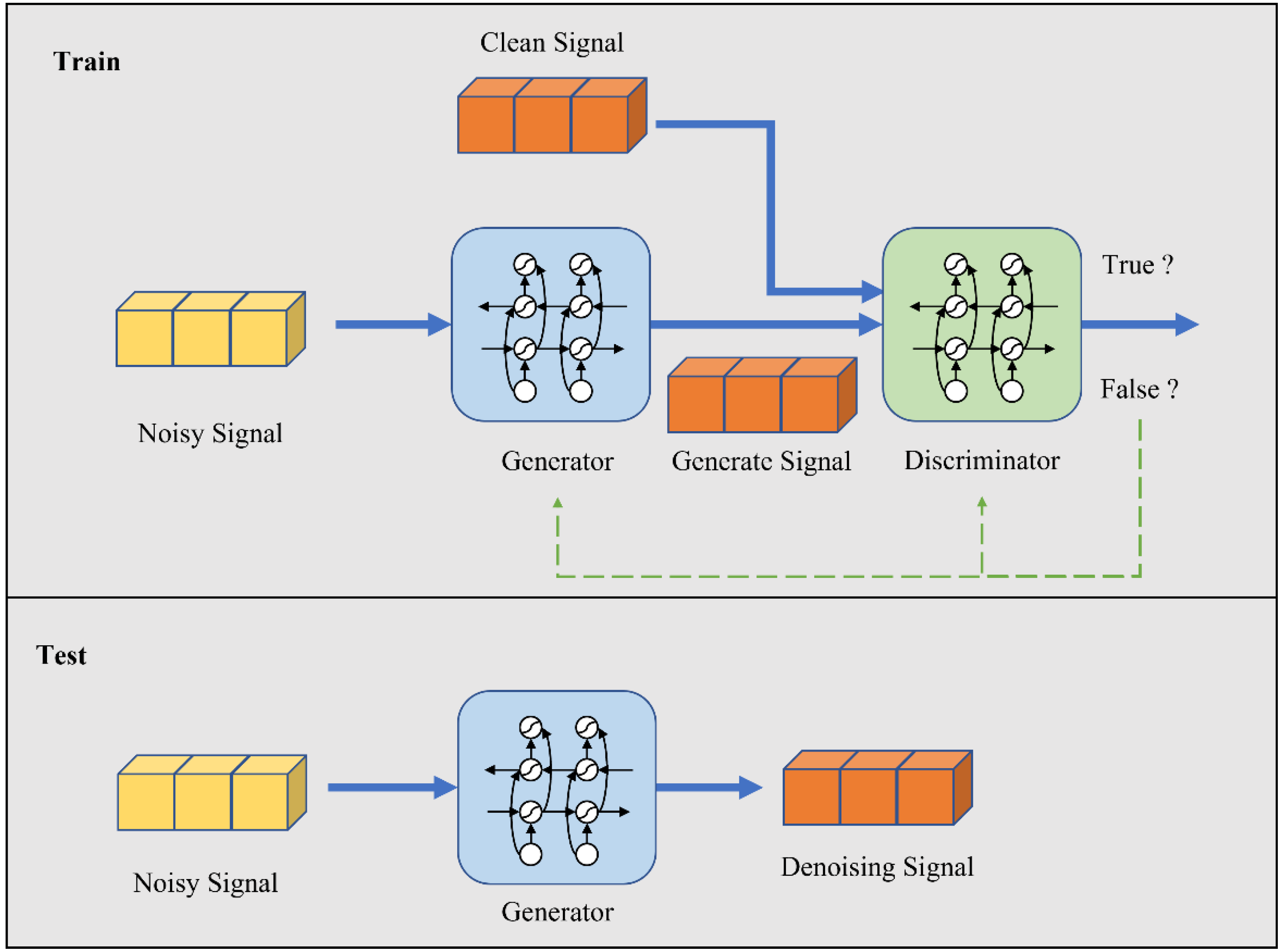

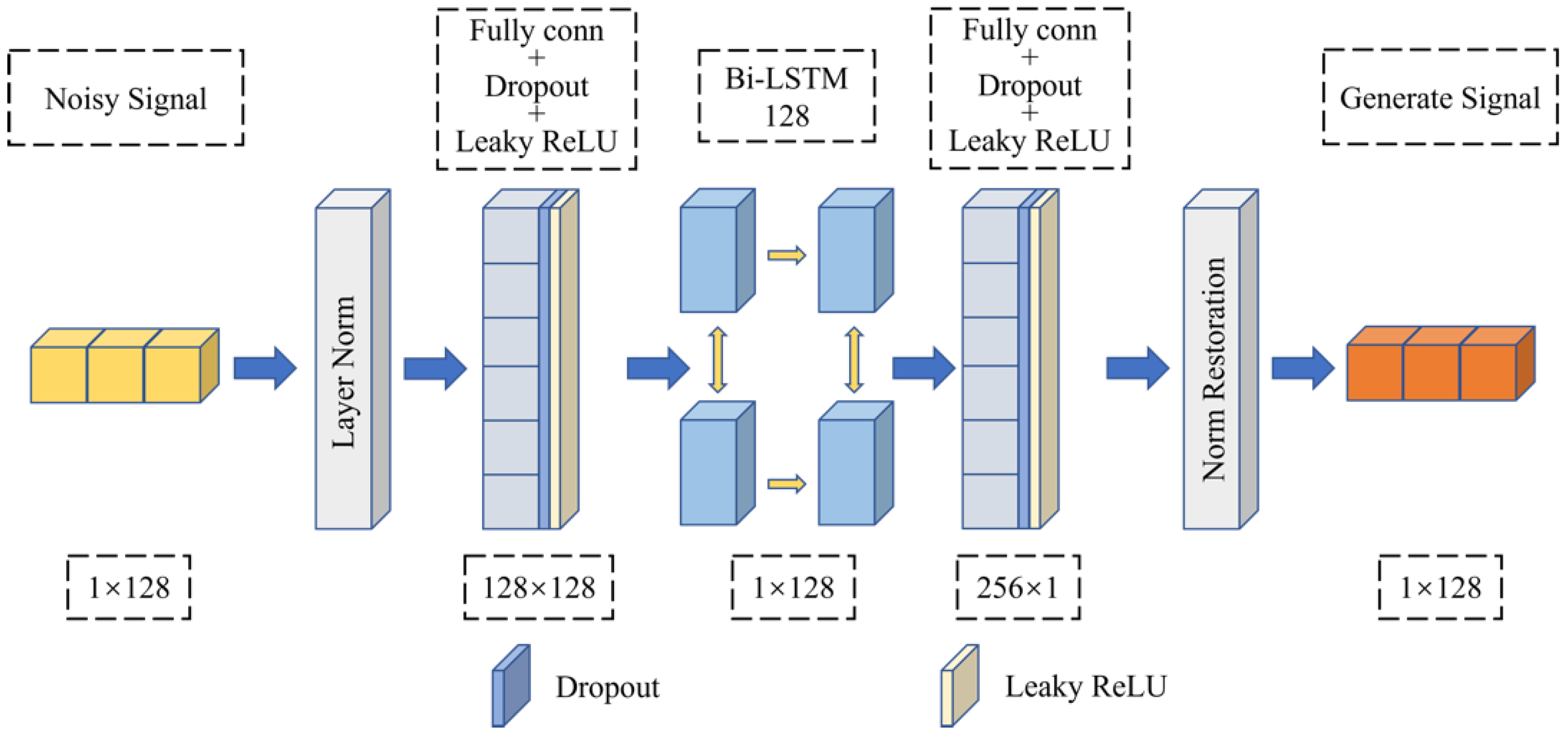
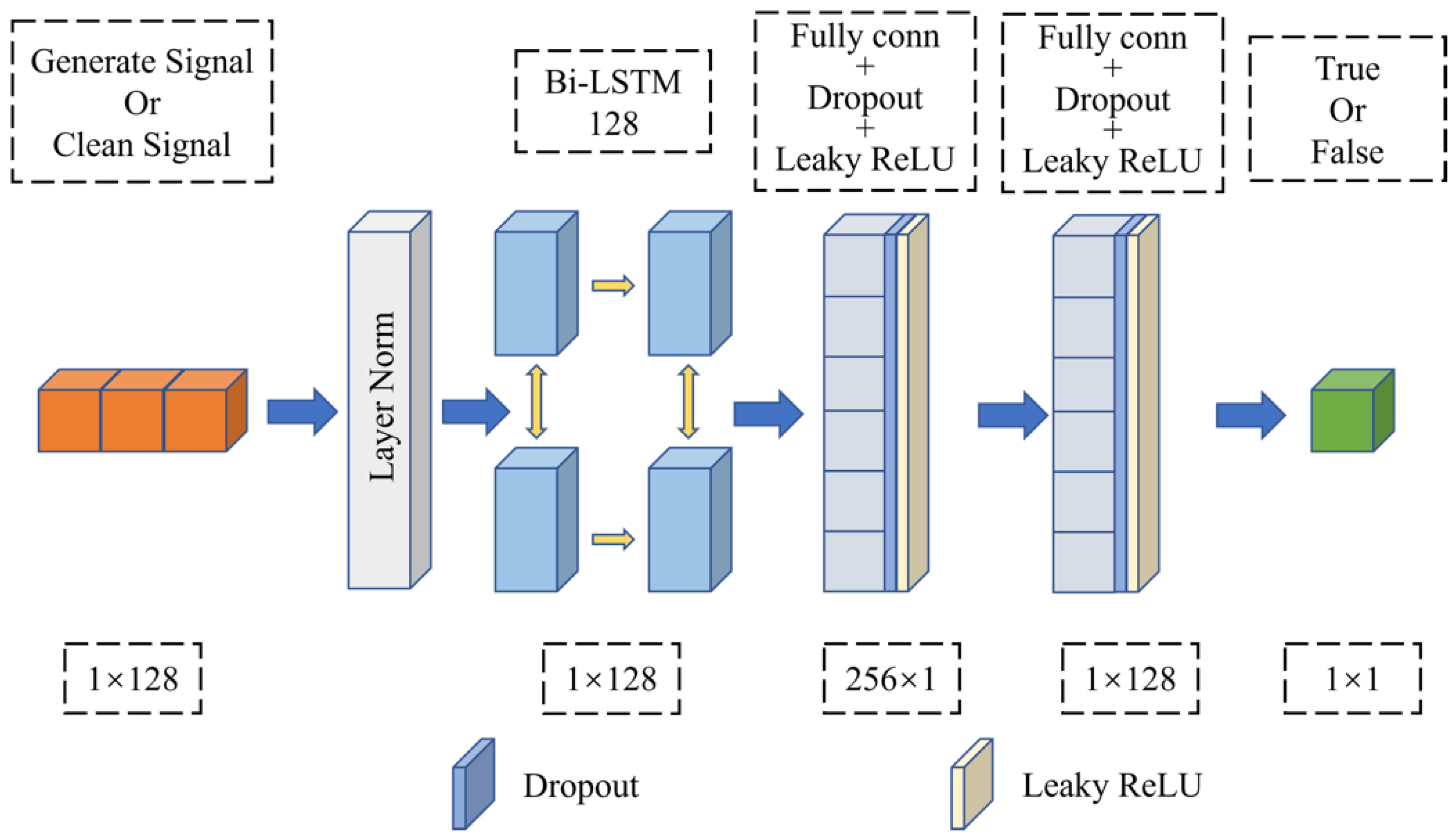
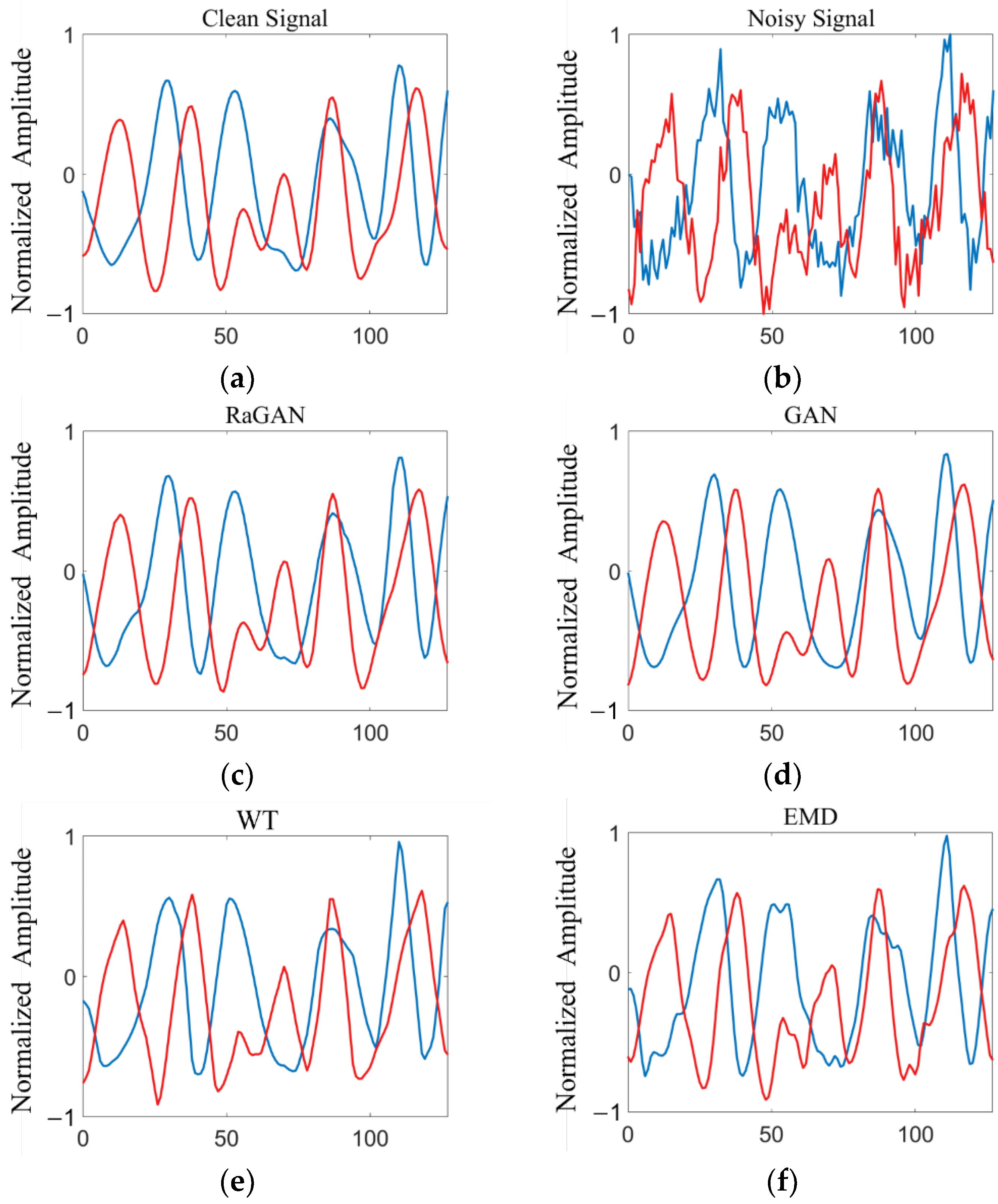
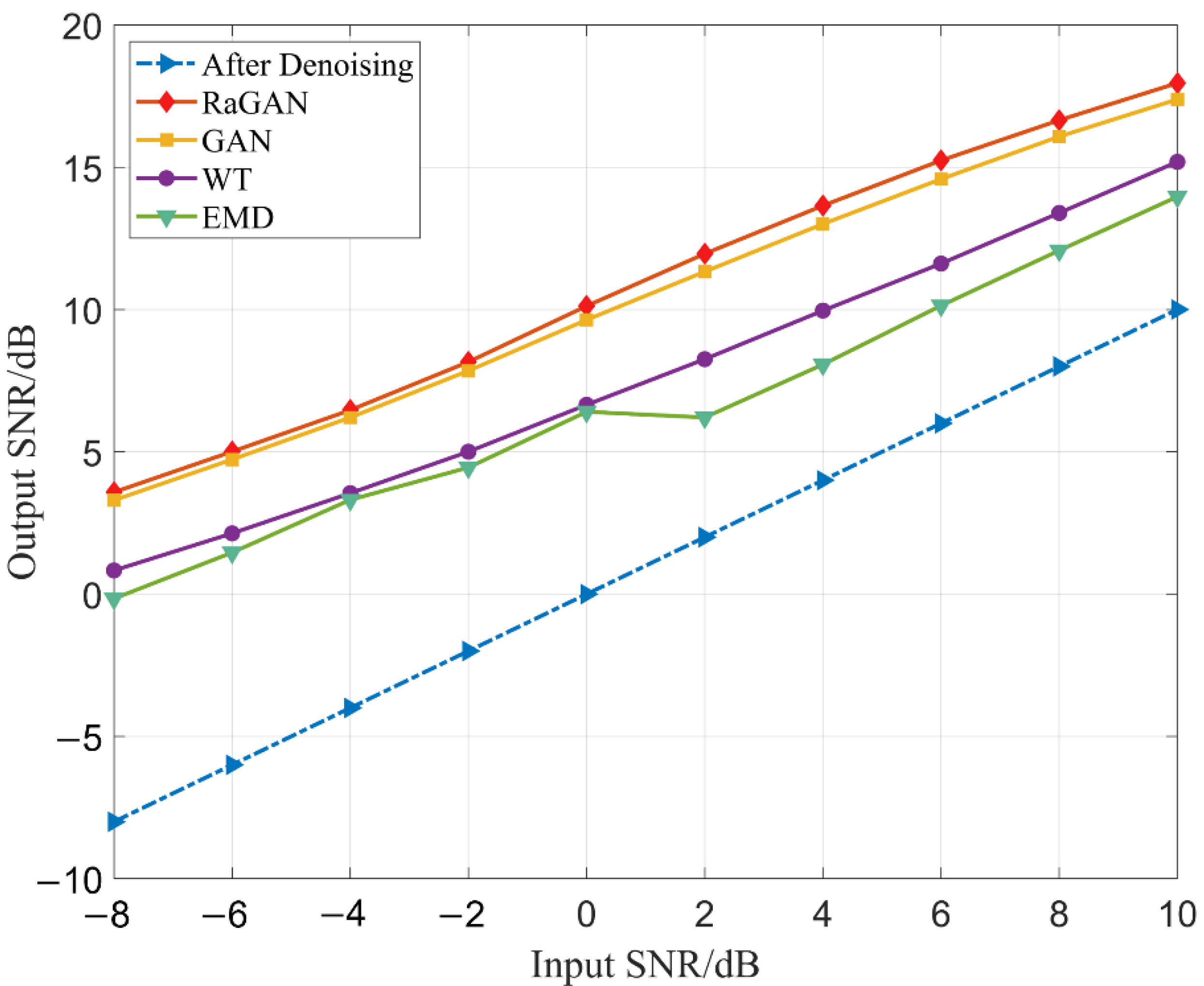
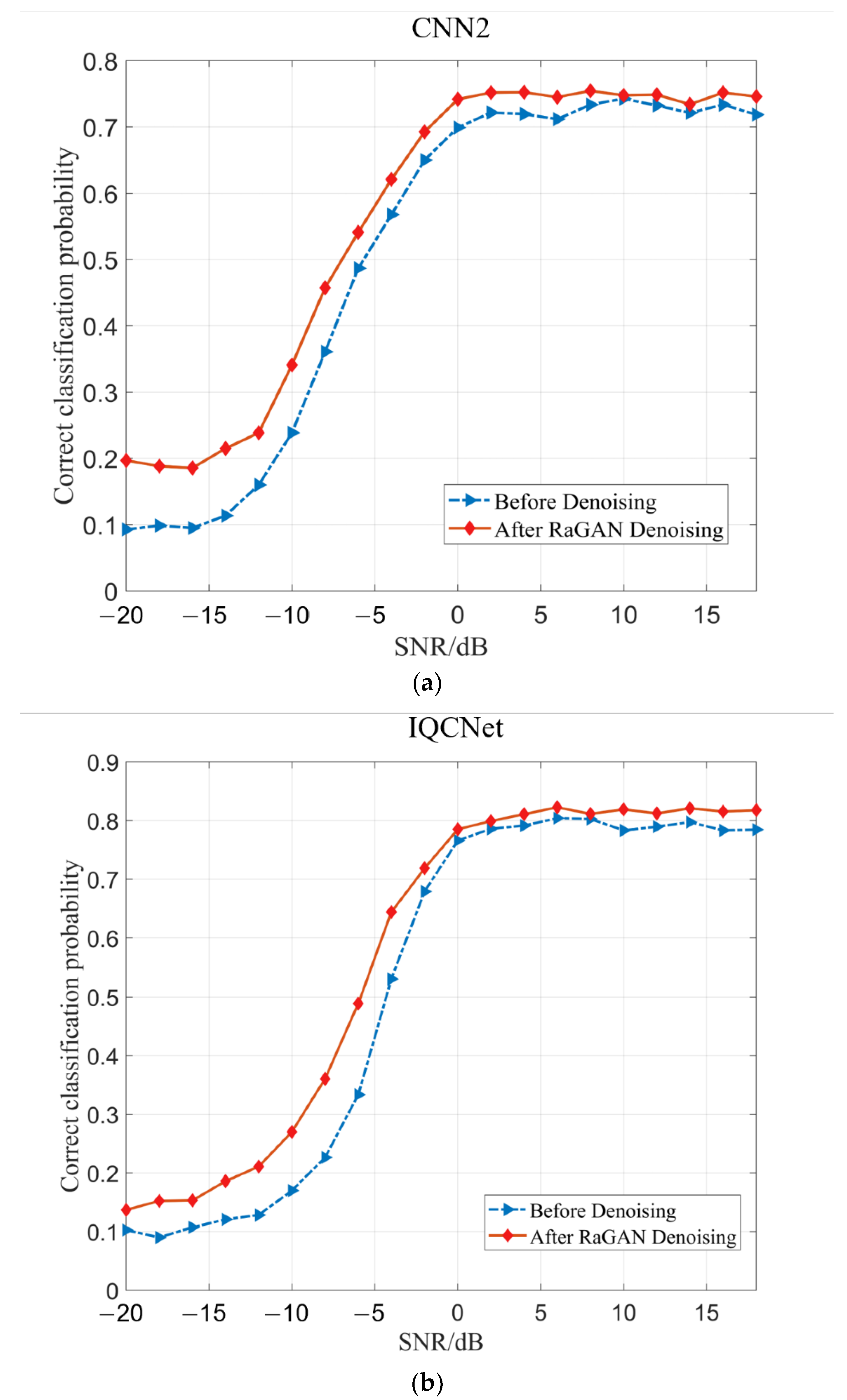
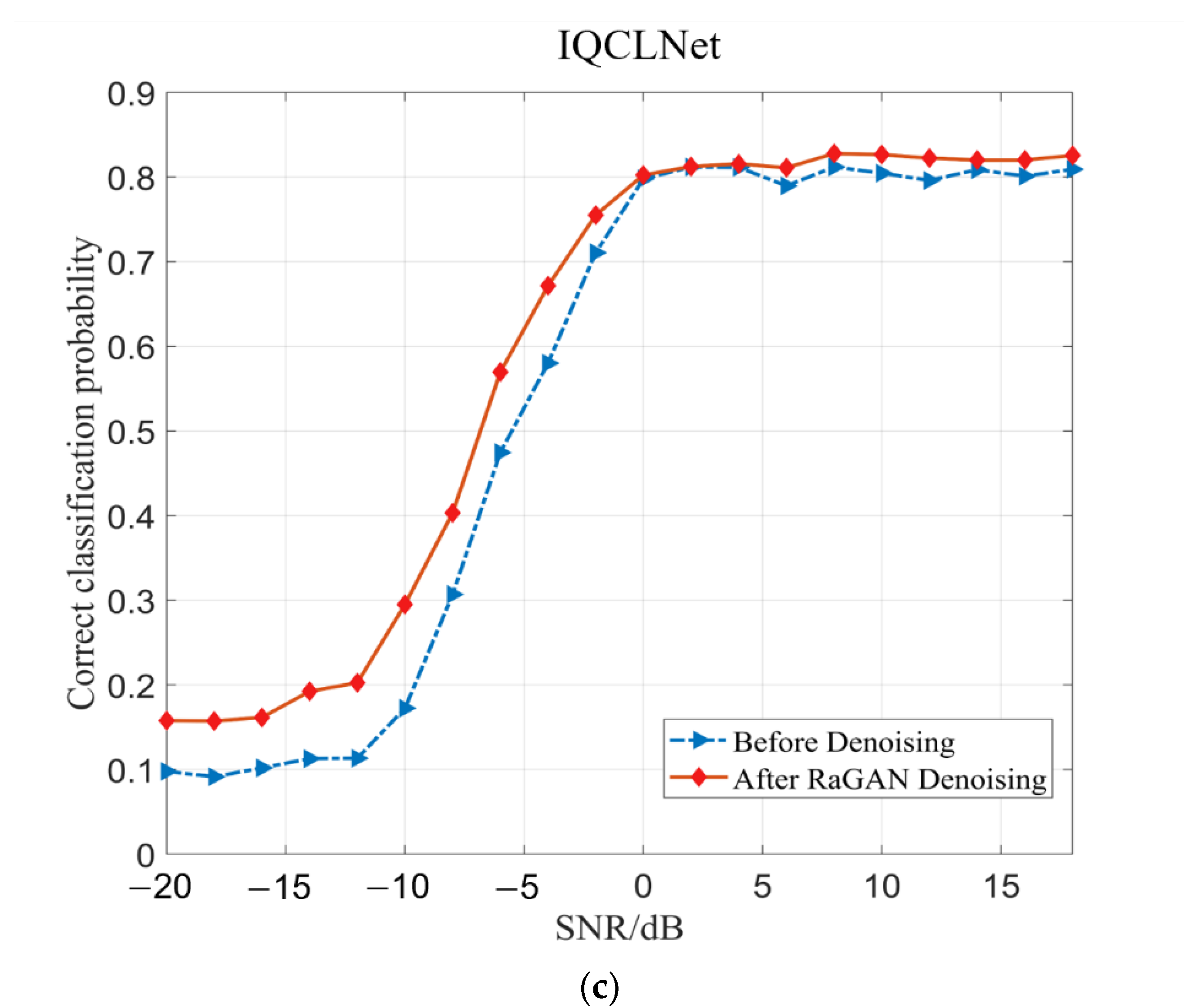
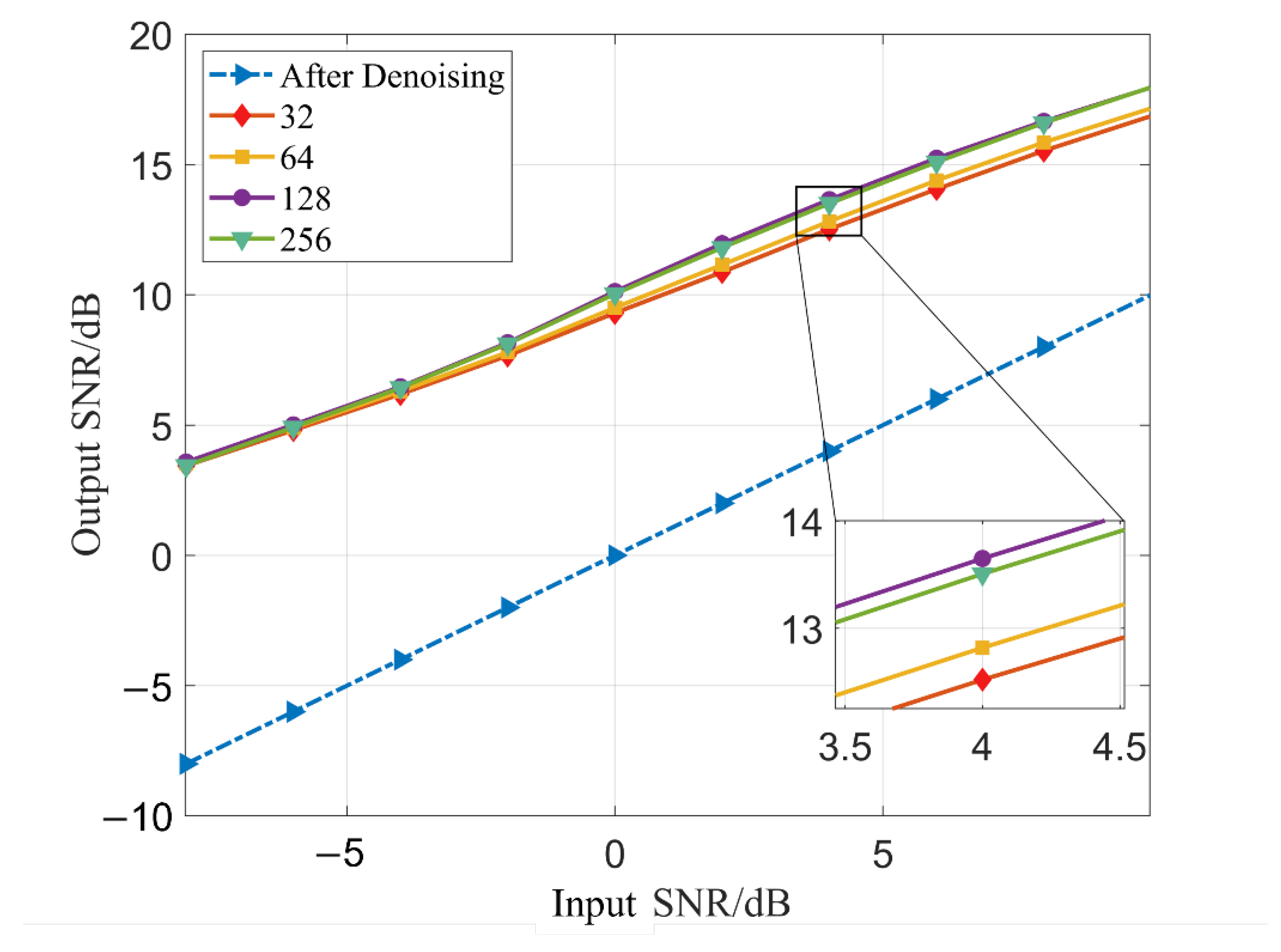
| Abbreviation | Definition |
|---|---|
| DL | Deep learning |
| RaGAN | Relativistic average generative adversarial network |
| Bi-LSTM | Bidirectional long short-term memory |
| SNR | Signal-to-noise ratio |
| WT | Wavelet transform |
| EMD | Empirical mode decomposition |
| GAN | Generative adversarial network |
| AWGN | Additive white Gaussian noise |
| CNN | Convolutional neural networks |
| ECG | Electrocardiogram |
| LSGAN | Least-square generative adversarial networks |
| CGAN | Conditional generative adversarial networks |
| TEM | Transient electromagnetic |
| ANN | Artificial neural network |
| RF | Radio frequency |
| D | Discriminator |
| G | Generator |
| LSTM | Long short-term memory |
| LN | Layer normalization |
| Dataset Information | |
|---|---|
| Modulation | 8PSK, BPSK, CPFSK, GFSK, PAM4, 16QAM, 64QAM, and QPSK |
| Length per Sample | 128 |
| Sampling Frequency | 1 MHz |
| SNR Range | [−8 dB, −6 dB,…, 10 dB] |
| Total Number of Samples | 80,000 vectors |
| Hardware or Software | Technical Parameter |
|---|---|
| Operation System | Windows 10 Home Chinese |
| CPU | Intel Xeon Silver 4212R |
| GPU | NVIDIA GeForce 3090 |
| Memory | 128 G |
| Python | Python 3.8.12 |
| Pytorch | Pytorch 1.11.0 |
| Hyperparameter | |
|---|---|
| 0.005 | |
| Batch size | 2048 |
| Epochs | 100 |
| Learning rate | 0.001 |
| Optimizer | Adam [31] |
| SNR/dB | RaGAN (dB) | GAN (dB) | WT (dB) | EMD (dB) |
|---|---|---|---|---|
| −8 | 3.58 | 3.30 | 0.83 | −0.16 |
| −6 | 5.01 | 4.73 | 2.13 | 1.46 |
| −4 | 6.47 | 6.21 | 3.55 | 3.31 |
| −2 | 8.16 | 7.85 | 5.00 | 4.45 |
| 0 | 10.12 | 9.64 | 6.65 | 6.41 |
| 2 | 11.96 | 11.33 | 8.25 | 6.21 |
| 4 | 13.65 | 13.01 | 9.96 | 8.07 |
| 6 | 15.24 | 14.58 | 11.61 | 10.14 |
| 8 | 16.65 | 16.08 | 13.39 | 12.07 |
| 10 | 17.96 | 17.38 | 15.19 | 13.96 |
| Hyperparameter | |
|---|---|
| Training set:Test set:Verification set | 6:2:2 |
| Batch size | 1024 |
| Epochs | 32 |
| Learning rate | 0.001 |
| Optimizer | Adam |
| WT | EMD | RaGAN | |
|---|---|---|---|
| Time (s) | 2.113 | 9.848 | 0.767 |
| SNR/dB | 32 (dB) | 64 (dB) | 128 (dB) | 256 (dB) |
|---|---|---|---|---|
| −8 | 3.44 | 3.53 | 3.58 | 3.44 |
| −6 | 4.80 | 4.90 | 5.01 | 4.99 |
| −4 | 6.19 | 6.30 | 6.47 | 6.43 |
| −2 | 7.66 | 7.80 | 8.16 | 8.12 |
| 0 | 9.30 | 9.505 | 10.12 | 10.04 |
| 2 | 10.87 | 11.15 | 11.96 | 11.81 |
| 4 | 12.52 | 12.82 | 13.65 | 13.51 |
| 6 | 14.05 | 14.39 | 15.24 | 15.10 |
| 8 | 15.52 | 15.85 | 16.65 | 16.58 |
| 10 | 16.86 | 17.15 | 17.96 | 17.96 |
Disclaimer/Publisher’s Note: The statements, opinions and data contained in all publications are solely those of the individual author(s) and contributor(s) and not of MDPI and/or the editor(s). MDPI and/or the editor(s) disclaim responsibility for any injury to people or property resulting from any ideas, methods, instructions or products referred to in the content. |
© 2023 by the authors. Licensee MDPI, Basel, Switzerland. This article is an open access article distributed under the terms and conditions of the Creative Commons Attribution (CC BY) license (https://creativecommons.org/licenses/by/4.0/).
Share and Cite
Peng, L.; Fang, S.; Fan, Y.; Wang, M.; Ma, Z. A Method of Noise Reduction for Radio Communication Signal Based on RaGAN. Sensors 2023, 23, 475. https://doi.org/10.3390/s23010475
Peng L, Fang S, Fan Y, Wang M, Ma Z. A Method of Noise Reduction for Radio Communication Signal Based on RaGAN. Sensors. 2023; 23(1):475. https://doi.org/10.3390/s23010475
Chicago/Turabian StylePeng, Liang, Shengliang Fang, Youchen Fan, Mengtao Wang, and Zhao Ma. 2023. "A Method of Noise Reduction for Radio Communication Signal Based on RaGAN" Sensors 23, no. 1: 475. https://doi.org/10.3390/s23010475
APA StylePeng, L., Fang, S., Fan, Y., Wang, M., & Ma, Z. (2023). A Method of Noise Reduction for Radio Communication Signal Based on RaGAN. Sensors, 23(1), 475. https://doi.org/10.3390/s23010475









